

88-108 MHz FM TUNERS
Receivers (tuner and amplifier in one unit) are generally not recommended for serious DX work. Dedicated quality FM tuners that feature digital frequency display, wide/narrow IF bandwidth, high sensitivity and image rejection are the main requirements for successful long distance reception.
This article includes a variety of receiving equipment, which are highly recommended for serious monitoring of VHF/UHF television and FM radio DX signals. Although the DX equipment included on this page are often relatively expensive, the outstanding performance is well worth the investment.

The Kenwood KT-6040 is potentially one of the most selective non-RDS FM tuners. This is mainly due to the KT-6040's series of eight filters. For example, here is the author's preferred filter combination for fringe DX work:
Wide: two SFE10.7MHY 110 KHz filters.
Normal: three SFE10.7MHY 110 KHz filters.
Narrow: four SFE10.7MT 80 KHz filters + two SFE10.7MHY 110 KHz filters.
Wide: CF1 (110) + CF2 (110).
Normal: CF1 (110) + CF3 (110) + CF4 (110).
Narrow: CF5 (80) + CF6 (80) + CF7 (80) + CF8 (80) + CF3 (110) + CF4 (110).
Installing Murata SFE10.7MF 50 KHz filters in the KT-6040 is not recommended. Several tests indicated that SFE10.7MF filters introduced excessive distortion, but with no apparent selectivity advantage.
As one progressively selects from wide to narrow IF bandwidth, more of the KT-6040's filters are switched in-line, so in the narrow position there are six filters in series, thus producing very steep skirt selectivity.
Preliminary tests indicate that unmodified KT-6040 (European version) and Onkyo T-9090 II tuners both have similar selectivity and RF image rejection. Once modified, the KT-6040's 80 KHz narrow selectivity is clearly superior to the T-9090 II's selectivity (four Murata 110 KHz filters).
When the 80 KHz filters are switched in, the KT-6040's weak signal sensitivity is high. The high sensitivity is probably mainly due to the KT-6040's 3SK121 GaAsFET first RF amplifier.
The KT-6040's selectivity is superior compared to all other tuners so far tested at my location. One example is how the KT-6040 is able to resolve weak daily aircraft scatter signals from 96.7 MHz 3ABC-FM Taralgon, VIC (407 miles / 655 km) - audio sample. The Onkyo T-9090 II (four 110 KHz filters) is unable to resolve 96.7 3ABC-FM. This is largely because of the adjacent 96.9 MHz 150 kw local (6km) Nova-FM signal.
Murata filters tend to have a slightly degraded selectivity curve on the high side of adjacent unwanted signals. This is also true for the KT-6040's 80 KHz filters. However, daily meteor scatter reception of 105.9 MHz 3ABC-FM Melbourne and 3ABC-RN Mildura next to local 150 kw 105.7 MHz 2JJJ-FM is not possible on any of my tuners, except the KT-6040 (80 KHz wide FM) and Icom R-8500 (15 KHz narrow FM).
One experienced UK DXer reports that the KT-6040 was more selective against adjacent channel QRM and thus allowing clear audio through from a weak signal that was only 100 kHz away from a 70+dB local station.
One potential problem with some KT-6040 tuners is a sluggish tuning dial response. This problem is thought to be caused by cheap encoders.
European, U.K., and Australian versions of the KT-6040 are indicated as having marginall higher usable (DIN) sensitivity (0.7 uV mono) compared to the general market Canadian and U.S.A. versions (0.95 uV mono).
For European FM DXers seeking very high 100 KHz adjacent selectivity, a KT-6040, modified with 80 and 110 KHz Murata ceramic filters, is probably the best option.
In 1991-92 the KT-6040 was officially released in Europe, Australia, and Canada. The KT-6040 isn't usually available second-hand in Australia. However, the KT-6040 appears fairly frequently on eBay Germany. Prices range from approximately 60-150 Euros.
RDS connection to a Conrad unit
The multiplex output (for the RDS signal) is available at TP4 (earth ground at TP5). TP4 is at the output of IC7-2/2.
Kenwood KT-6040 AM/FM tuner specifications (unmodified)
Rotary tuning dial.
25 kHz tuning steps
Eight IF filters
Tuning range: 87.50 - 108.00 MHz
FM SECTION
50 dB Quieting Sensitivity
Mono - 15.3 dBf
Stereo - 37.2 dBf
Usable Sensitivity (DIN at 75 Ohm)
Mono: 0.7µV
Stereo: 25 µV
Selectivity (unmodified)
(DIN +/-300 kHz 80 dB (NORMAL))
(DIN +/-200 kHz 80 dB (NARROW))
Image Rejection Ratio (at 98 MHz)
90 dB
IF Rejection Ratio (at 98 MHz)
110 dB
Spurious Response Ratio (at 98 MHz)
100 dB
AM Suppression Ratio
68 dB
Signal to Noise Ratio (DIN weighed at 1 kHz)
Mono - 83 dB (85.2 dBf input)
Stereo - 76 dB (85.2 dBf input)
KT-6040 RF and IF alignment instructions.


The Onkyo T-9090 was replaced by the T-9090 11. The T-9090 11 is superior to the earlier T-9090 with regard to selectivity, tuning steps, antenna inputs, remote control, and number of memory pre-sets.
US TV and FM DXer Jeff Kadet compared his Onkyo T-9090 II to the near-legendary McINTOSH MR78, and found that the selectivity and sensitivity on both tuners were virtually identical. However, the Onkyo T-9090 II was preferred, because it includes digital frequency readout, 20 memory pre-sets, and 25 KHz tuning steps. A DXer living in Sydney, Australia, once received a 1,400 mile FM station via tropospheric ducting from New Zealand. Receiving equipment consisted of just an Onkyo T-9090 II tuner and indoor T-ribbon dipole!
The T-9900 is the European version of the 1985 T-9090. The T-9990 is the European version of the 1988 T-9090 II.
Onkyo T-9090 II specifications
Tuning range: 87.5 - 108 MHz
25 KHz tuning steps.
Usable sensitivity: Mono: 0.8uV (S/N 26 dB, 40 KHz Deviation.) DIN
Stereo: 20uV, (S/N 46 dB, 40 KHz Deviation.) DIN
50dB Quieting Sensitivity: Mono: 15.8dBf, 1.7uV
Stereo: 37.2dBf, 20uV
Capture Ratio: 1dB
Image Rejection Ratio: 100dB
IF Rejection Ratio: 100dB
Signal -to -Noise -Ratio: Mono: 95dB (IHF)
Stereo: 85dB (IHF)
Selectivity: 80dB DIN (+/-300 KHz, IF: super narrow)
95dB (+/-400 KHz)


The Onkyo T-4711 FM tuner is also highly recommended. This tuner has similar performance to the T-9090 II, but with the added bonus of a tuning dial. Minimum 25 KHz tuning steps is another desirable feature. The T-4711 is now only available second-hand.
Because the Onkyo T-4711 has only four filter positions in the super narrow bandwidth position, the selectivity is down compared to the Onkyo T-9090 II (five filters), or Kenwood KT-6040 (eight filters).


The Onkyo T-488F was initially released about 1993. Performance is very similar to the T-9090 II. However, unlike the T-9090 II, RDS is also included.

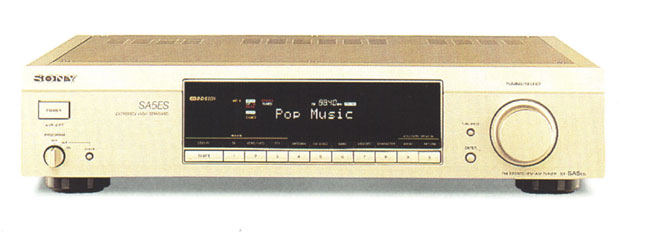
The Sony ST-SA5ES FM tuner has two 75 ohm antenna inputs, 100dB image rejection, RDS capability, rotary tuning dial, digital signal strength meter, and good sensitivity.
Because the ST-SA5ES has only four filter positions in the super narrow bandwidth position, the selectivity is down compared to the T-9090 II (five filters), KT-6040 (eight filters).
50 KHz minimum tuning steps is also a slight disadvantage.
Sony ST-SA5ES technical specifications
Tuning
range: 87.5 - 108 MHz (50 KHz steps)
Sensitivity - usable 10.3 dBf 0.9 uV (75 ohms), 1.8 uV (300 ohms)
Sensitivity at 50dB 38.5 dBf 23 uV (75 ohms), 46 uV
(300 ohms)
Harmonic distortion Wide: 0.004% (mono)
0.0075%
(stereo)
Narrow: 0.04% (mono)
0.07% (stereo)
Stereo seperation Wide: 70
dB
Narrow: 50 dB
Selectivity Narrow: 65 dB (+/- 300 KHz)
Wide: 70 dB
(+/- 400 KHz)
Image rejection ratio 100 dB
One current production RDS tuner, which is highly recommended by Girard Westerberg, is the Denon TU 1500RD. The TU 1500RD is currently $699.00, and also available in Australia: http://www.duratone.com.au/html/products/denon/tu-1500rd.htm.
European DXers generally prefer the following FM tuners:
Kenwood KT-6040.
Onkyo T-4711.
Onkyo T-9990 (European version of the T-9090 II).
Onkyo T-4970.
Sony ST-SA3ES
Sony ST-SA5ES.

Car tuners for mobile FM DX reception

The Pioneer DEH-P5800MP is one of several tuners that feature Supertuner® IIID™ technology. The full range is detailed at:
The DEH-P5800MP (80dB +/- 200 kHz) selectivity spec is very good. Perhaps Pioneer use a variation of DYNAS technology to achieve high adjacent channel selectivity. A rotary tuning dial is another bonus. The DEH-P5800MP (0.7 uV, 75 ohm, mono, S/N 30 dB) sensitivity spec is also very good. The high-end Onkyo Integra tuners feature similar sensitivity specifications.
Tony Mann (Perth) comments that the DEH-P5800MP is free of any adjacent channel interference +/- 200 KHz of strong locals. The weak signal performance is also good, as evident with interstate Es DX present on the DEH-P5800MP.
FM antennas

The Antenna Performance APS-13 is probably the best commercially produced antenna currently available for 88-108 MHz deep fringe FM reception. The forward gain is 10dBd, and average front to back ratio is 30dB! For futher details, visit the Antenna Performance web page.
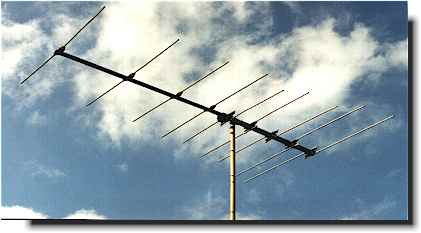
For USA/Canada area DXers, the Antenna Performance APS-9 is smaller, hence more economical and practical for DXers.

USA DXers tend to use the following range of 88-108 MHz FM antennas:
APS-13 or APS-9 log-periodic FM antennas.
Chromstar CA-6065, 9 element log-periodic antenna.
Antennacraft (Tandy) FM-10, 10 element log-periodic/yagi antenna.
Channel Master Stereo Probe 9, 9 element log-periodic/yagi antenna.
Many UK and European DXers use the Triax FM-8, 8 element 87-108 MHz yagi. This antenna features two reflectors, one dipole, and five directors. Triax is located in Denmark. Fuba (Germany) also make a 8 element yagi, with a very similar design to the Triax FM-8.
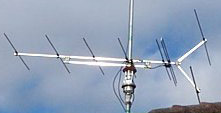
Australian FM DXers use the following range of 88-108 MHz FM antennas:
Matchmaster FM-G8, eight element 88-108 MHz yagi.
Hills 3-4-5, eight element 88-108 MHz FM/band 2 TV yagi.

Portable
Radios.
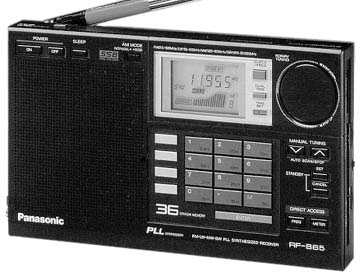
Another excellent AM FM DX performer is the Grundig YB-400 or YB-400PE. For more information, go to http://www.dxing.com/rx/yb400.htm
One portable radio that has received good reports from European FM DXers, is the Grundig Satellit 700. Some DXers have modified this radio with Murata 110 KHz filters.
Murata SFE10.7 MT 80 KHz, SFE10.7MY-A 110 KHz, and SFE10.7MJA10 150 KHz filters are currently available in small quantities from the FM and TV DX plaza.
Walkman type radios for FM DX
I received the following message from Eddy, Canada:
"The Sony srf-s83 is a personal walkman type radio which delivers better
selectivity and sensitivity than ANY other personal radio by Sony,
Panasonic, Radio shack, etc. It's one of the best personal radios on
this planet (trust me, I've tried at least 10 models from various
manufacturers).
See the review at: www.simplyradios.com for another sensitivity opinion"
Is the Icom R-7000 suitable for 88-108 MHz FM DX?
Television DX Receivers
Choosing a receiver for Television DX is quite difficult because most TV sets were initially only intended for local reception. I have found only one TV tuner, which was especially designed for reception of long distance Television reception.
HS Publications (7 Epping Close, Derby, DE22 4HR, England), sell the D100 TV tuner/converter. This tuner uses a MOSFET varicap tuner covering 45-860 MHz. It also features variable IF bandwidth to improve selectivity. The D100 also converts the TV audio to 95-100 MHz for use with a FM tuner. TV audio can also be received on 36 MHz using a scanner. A excellent combination is a D100, and Icom R7000 modified with MURATA SFE10.7 MHY-A, 110 KHz filters. The output frequency of the D100 is at UHF. Veteran TV DXer Bob Cooper has also used the D100. The D100 is used extensively in Europe, and has received rave reviews from DXers.
MULTI-STANDARD NTSC, SECAM, AND PAL TV SETS It is next to impossible to find TV sets which are
both multi-standard, and
also suitable for DX TV. The following extract from
Every serious TV and FM DXer should use a good quality scanner. The Icom R-8500, 7100, and 7000 are all excellent. The AOR AR-5000 is very good, however it is also very expensive.
If you are serious about using a scanner for FM DX, I would remove the stock wide ceramic IF filters, and install some 110 KHz SFE-MHY-A Murata IF filters.


When I first tried my unmodified R7000 for FM DX, I was
disappointed by the FM wide selectivity. This is because
the R7000 only used (1) 230 KHz, and (1) 150 KHz Murata ceramic filters. With this arrangement, I
found that the adjacent (+/-200 KHz) selectivity was relatively
poor.
I replaced the stock filters with two 110 KHz Toko
ceramic filters. The selectivity was considerably better, and
I also found that tuning +/- 200 KHz of locals signals
produced mainly white noise.
The only disadvantage was 1-2 dB reduced sensitivity.
This is because the Toko filters had higher insertion
loss. This did not concern me because I use a tunable
88-108 MHz Mosfet pre-amp, which compensates for any slight losses in the IF stage. The pre-amp also partially
compensates for the R7000's untuned RF front-end.
In city areas, you will find several images of local
stations across the dial. A tuned pre-amp, or bandpass
filter will improve the R7000's image and overload
problems.
My next project is to replace the two Toko 110 filters
with Murata SFE10.7MHy-A 110KHz filters. The Murata filters typically
feature lower signal loss and improved shape factor.
I once compared my modified R7000 to the TEAC T-515 FM tuner
(60dB +/- 300 KHz selectivity). The R7000 was better,
though not as good as my Onkyo T-9090 11 (80 dB +/-
300 KHz). I would estimate that the R7000, with two
110 KHz filters has a selectivity specification of ~ 70dB +/-
300 KHz.

![]() HS Publications TV FM DX 2003 equipment catalogue - home of the D100 DXTV tuner PDF version.
HS Publications TV FM DX 2003 equipment catalogue - home of the D100 DXTV tuner PDF version.
will explain why:
"At first, a multi-system TV receiver may seem the
ideal choice for TV DX-ing but it does not address
the complex reception problems encountered,
particularly in VHF Bands I and III where interleaved
channel allocations exist.
Multi-system receivers are mainly intended for the
traveler or for use in countries where more than one TV system is available. The main drawback with such
a receiver for DX-ing is its inherently wide vision I.F. bandwidth, which is necessary for high-definition
pictures.
Although good results may be obtained with
local-quality signals, the shortcomings of such a receiver begin to show if attempting to resolve
anything other than a strong solitary signal.
Other drawbacks associated with current TV receiver trends include video channel muting, when the signal level is considered inadequate for domestic viewing, plus complex set-up menus and tuning arrangements.
The enthusiast relying on an `up-converter' device(VHF to UHF frequency converter) for viewing VHF signals via a UHF TV receiver will also experience
shortcomings due to the use of the wide vision I.F.
bandwidth of the TV. Not to mention the problem of locating the channel in the absence of a signal!"
Multi-standard TV sets are likely more common in Europe, because of neighboring countries that use different standards. For example, if you lived in Switzerland, you would be able to receive pictures from France, Germany, Italy, and Austria on a daily basis.
The German companies Grundig and Blaupunkt make quality VHF/UHF multi-standard TV sets.

TV DX antennas
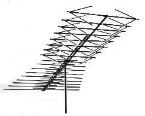
Channel Master 1126, 10 element chA2-A6 yagi.
Wineguard (Prostar) YA-1026, 10 element chA2-A6 yagi.
Wineguard (Prostar) YA-6260, 6 element chA2-A6 yagi.
Antenna Craft (Tandy) Y10-2-6, 10 element chA2-A6 yagi.
ChA2-A13 wideband USA VHF DX antennas:
Channel Master 3600A.
Channel Master 3601A.
Chromstar CA-5254.
Antennacraft CS-1100, 33 element log periodic.
Antennacraft CS-1000, 30 element log-periodic.
Australian DXers have very limited choice regarding TV antennas:
Hills 205/02, 5 element 45-70 MHz yagi.
Hills TL/4, ch1-11 55-220 MHz log periodic.
The CLP5130 log periodic 50-1300 MHz antenna is currently very popular for DX TV and FM reception in Japan. The official web site for the CLP5130 is at http://www.cd-corp.com/eng/ama/5130.htm

Links
![]() Antennas and receivers in current use by US TV and FM DXers.
Antennas and receivers in current use by US TV and FM DXers.
![]() Scanners and receivers for DX TV monitoring.
Scanners and receivers for DX TV monitoring.